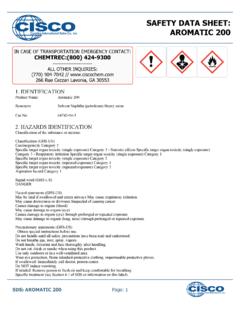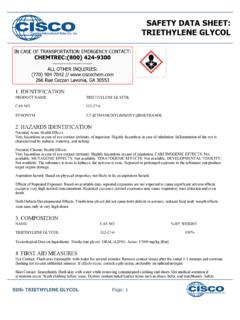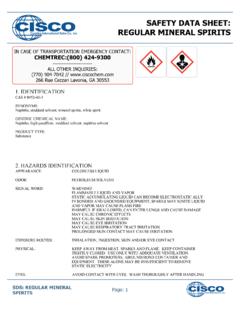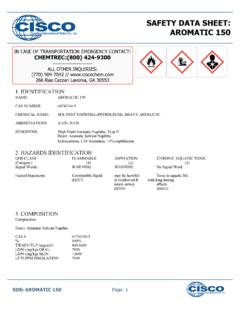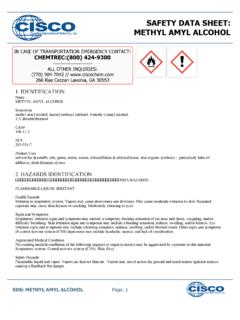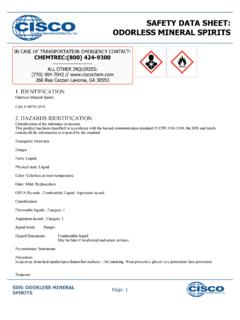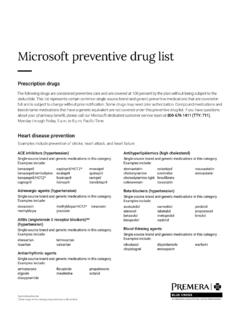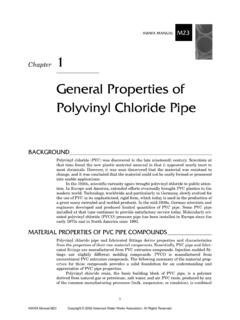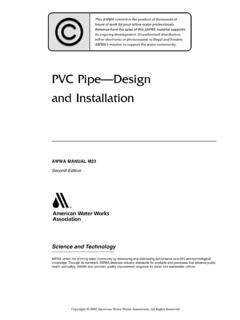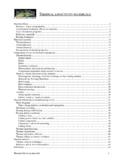Transcription of SAFETY DATA SHEET: POLYETHYLENE GLYCOL 3350
1 SAFETY data sheet : POLYETHYLENE GLYCOL 3350. IN CASE OF TRANSPORTATION EMERGENCY CONTACT: CHEMTREC:(800) 424-9300. ----------------------- ALL OTHER INQUIRIES: (770) 904-7042 // 266 Rue Cezzan Lavonia, GA 30553. 1. IDENTIFICATION. Product Name: POLYETHYLENE GLYCOL 3350. CAS NO: 25322-68-3. TSCA: TSCA 8(b) inventory: POLYETHYLENE GLYCOL 3350. Synonymn: PEG 3350. Chemical formula: H(OCH2CH2)nOH. 2. HAZARDS IDENTIFICATION. Caution! This is expected to be a low hazard for usual industrial handling. May cause irritation. Good laboratory procedures are recommended when handling this compound. Target Organs: None. Potential Health Effects Eye: May cause mild eye irritation. May cause mechanical irritation. Skin: Low hazard for usual industrial handling. Ingestion: Causes gastrointestinal irritation with nausea, vomiting and diarrhea. Low hazard for usual industrial handling. Inhalation: Low hazard for usual industrial handling.
2 Chronic: Prolonged exposure may cause eye irritation 3. COMPOSITION. NAME CAS NO % BY WEIGHT. POLYETHYLENE GLYCOL 3350 25322-68-3 100%. Toxicological data on Ingredients: POLYETHYLENE GLYCOL 3350: ORAL (LD50): Acute: 4000 mg/kg [Rat]. 20000 mg/kg [Mouse]. DERMAL (LD50): Acute: 20000 mg/kg [Rabbit]. 4. FIRST AID MEASURES. EYES: Gently lift eyelids and flush continuously with water. If irritation develops, get medical aid. SDS: POLYETHYLENE GLYCOL Page: 1. 3350. SKIN: Flush skin with plenty of water for at least 15 minutes while removing contaminated clothing and shoes. Get medical aid if irritation develops or persists. Wash clothing before reuse. INGESTION: Never give anything by mouth to an unconscious person. Do NOT induce vomiting. If conscious and alert, rinse mouth and drink 2-4 cupfuls of milk or water. Wash mouth out with water. Get medical aid if irritation or symptoms occur. INHALATION: Remove from exposure and move to fresh air immediately.
3 If not breathing, give artificial respiration. If breathing is difficult, give oxygen. Get medical aid if cough or other symptoms appear. 5. FIRE FIGHTING MEASURES. Autoignition Not available. Temperature: Flash Point: 279 deg C ( deg F). Explosion limits Lower:: Not available Explosion limits Upper: Not available : NFPA Rating: health: 0; flammability: 1; instability: 0;. Flammability of the Product: May be combustible at high temperature. Products of Combustion: These products are carbon oxides (CO, CO2). Fire Hazards in Presence of Various Substances: Not available. Explosion Hazards in Presence of Various Substances: Risks of explosion of the product in presence of mechanical impact: Not available. Risks of explosion of the product in presence of static discharge: Not available. Explosive in presence of oxidizing materials. Fire Fighting Media and Instructions: SMALL FIRE: Use DRY chemical powder. LARGE FIRE: Use water spray, fog or foam.
4 Do not use water jet. Special Remarks on Fire Hazards: Not available. Special Remarks on Explosion Hazards: Not available. 6. ACCIDENTAL RELEASE MEASURES. Small Spill: Use appropriate tools to put the spilled solid in a convenient waste disposal container. Finish cleaning by spreading water on the contaminated surface and dispose of according to local and regional authority requirements. Large Spill: Use a shovel to put the material into a convenient waste disposal container. Finish cleaning by spreading water on the contaminated surface and allow to evacuate through the sanitary system. 7. HANDLING AND STORAGE. Precautions: Keep away from heat. Keep away from sources of ignition. Empty containers pose a fire risk, evaporate the residue under a fume hood. Ground all equipment containing material. Do not ingest. Do not breathe dust. If ingested, seek medical advice immediately and show the container or the label.
5 Storage: Keep container dry. Keep in a cool place. Ground all equipment containing material. Keep container tightly closed. Keep in a cool, well-ventilated place. Combustible materials should be stored away from extreme heat and away from strong oxidizing agents. 8. exposure CONTROLS AND PERSONAL PROECTION. Engineering Controls: SDS: POLYETHYLENE GLYCOL Page: 2. 3350. Use process enclosures, local exhaust ventilation, or other engineering controls to keep airborne levels below recommended exposure limits . If user operations generate dust, fume or mist, use ventilation to keep exposure to airborne contaminants below the exposure limit. Personal Protection: SAFETY glasses. Lab coat. Dust respirator. Be sure to use an approved/certified respirator or equivalent. Gloves. Personal Protection in Case of a Large Spill: Splash goggles. Full suit. Dust respirator. Boots. Gloves. A self contained breathing apparatus should be used to avoid inhalation of the product.
6 Suggested protective clothing might not be sufficient; consult a specialist BEFORE handling this product. exposure limits : Not available. 9. PHYSICAL AND CHEMICAL PROPERTIES. Physical state and appearance: Solid. Odor: Not available. Taste: Not available. Molecular Weight: 3350 g/mole Color: Not available. pH (1% soln/water): 6 [Acidic.]. Boiling Point: Not available. Melting Point: 56 C ( F). Critical Temperature: Not available. Specific Gravity: (Water = 1). Vapor Pressure: Not applicable. Vapor Density: Not available. Volatility: Not available. Odor Threshold: Not available. Water/Oil Dist. Coeff.: Not available Ionicity (in Water): Not available. Dispersion Properties: See solubility in water, methanol, diethyl ether. Solubility: Easily soluble in cold water. Soluble in hot water, methanol, diethyl ether. 10. STABILITY AND REACTIVITY. Stability: The product is stable. Instability Temperature: Not available.
7 Conditions of Instability: Not available. Incompatibility with various substances: Not available. SDS: POLYETHYLENE GLYCOL Page: 3. 3350. Corrosivity: Non-corrosive in presence of glass. Special Remarks on Reactivity: Not available. Special Remarks on Corrosivity: Not available. Polymerization: No. 11. TOXICOLOGICAL INFORMATION. CAS# 25322-68-3: Draize test, rabbit, eye: 500 mg/24H Mild; Draize test, rabbit, eye: 100 uL Mild;. Draize test, rabbit, eye: 500 mg Mild;. Draize test, rabbit, eye: 500 mg Mild;. Draize test, rabbit, eye: 500 mg Mild;. Draize test, rabbit, eye: 500 mg Mild;. Draize test, rabbit, eye: 500 mg/24H Mild;. Draize test, rabbit, eye: 500 mg/24H Mild;. Draize test, rabbit, eye: 500 mg Mild;. Draize test, rabbit, eye: 500 mg/24H Mild;. Draize test, rabbit, skin: 500 mg/24H Mild;. Draize test, rabbit, skin: 500 mg/24H Mild;. Draize test, rabbit, skin: 500 mg Mild;. Oral, mouse: LD50 = 34 gm/kg.
8 Oral, mouse: LD50 = 31 gm/kg;. Oral, mouse: LD50 = 28915 mg/kg;. LD50/LC50: Oral, mouse: LD50 = 36 gm/kg; Oral, rabbit: LD50 = 17300 mg/kg;. Oral, rabbit: LD50 = 76 gm/kg;. Oral, rabbit: LD50 = 14 gm/kg;. Oral, rabbit: LD50 = 17300 mg/kg;. Oral, rabbit: LD50 = 26800 mg/kg;. Oral, rabbit: LD50 = 19 gm/kg;. Oral, rabbit: LD50 = 28900 mg/kg;. Oral, rabbit: LD50 = 76 gm/kg;. Oral, rat: LD50 = 28 gm/kg;. Oral, rat: LD50 = 31640 mg/kg;. Oral, rat: LD50 = 27500 mg/kg;. Oral, rat: LD50 = 22 gm/kg;. Oral, rat: LD50 = 30200 mg/kg;. Oral, rat: LD50 = 600 mg/kg;. Oral, rat: LD50 = 30 gm/kg;. Oral, rat: LD50 = 32 gm/kg;. Oral, rat: LD50 = 1054. Carcinogenicity: POLYETHYLENE GLYCOL - Not listed as a carcinogen by ACGIH, IARC, NTP, or CA Prop 65. Other: Standard Draize Test: Administration onto the skin (rabbit) = 500 mg/24H (Mild). Standard Draize Test: Administration into the eye (rabbit) = 500 mg/24H (Mild). 12. ECOLOGICAL INFORMATION.
9 Ecotoxicity: Not available. BOD5 and COD: Not available. Products of Biodegradation: Possibly hazardous short term degradation products are not likely. However, long term degradation products may arise. SDS: POLYETHYLENE GLYCOL Page: 4. 3350. Toxicity of the Products of Biodegradation: The products of degradation are more toxic. Special Remarks on the Products of Biodegradation: Not available. 13. DISPOSAL CONSIDERATIONS. Description of waste residues and information on their safe handling and methods of disposal, including the disposal of any contaminated packaging: Recycle to process, if possible. Consult your local or regional authorities. 14. TRANSPORT INFORMATION. DOT Classification: Not a DOT controlled material (United States). Identification: Not applicable. Special Provisions for Transport: Not applicable. 15. REGULATORY INFORMATION. Federal and State Regulations: TSCA 8(b) inventory: POLYETHYLENE GLYCOL 3350.
10 Other Regulations: Not Other Classifications: WHMIS (Canada): Not controlled under WHMIS (Canada). DSCL (EEC): R16- Explosive when mixed with oxidizing substances. HMIS ( ): Health Hazard: 0. Fire Hazard: 1 Reactivity: 0. Personal Protection: E. National Fire Protection Association ( ): Health: 0. Flammability: 1. Reactivity: 0. Specific hazard: Protective Equipment: Gloves. Lab coat. Dust respirator. Be sure to use an approved/certified respirator or equivalent. SAFETY glasses. 16. OTHER INFORMATION. CISCO believes that the information on this MSDS was obtained from reliable sources. However, the information is provided without any warranty, expressed or implied, regarding its correctness. Some information presented and conclusions drawn herein are from sources other than direct test data on the substance itself. The conditions or methods of handling, storage, use and disposal of the product are beyond our control and may be beyond our knowledge.
